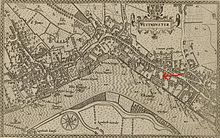- Savoy Palace
-
Coordinates: 51°30′38″N 0°7′13″W / 51.51056°N 0.12028°W
The Savoy Palace was considered the grandest nobleman's residence of medieval London, until it was destroyed in the Peasants' Revolt of 1381. It fronted the Strand, on the site of the present Savoy Theatre and the Savoy Hotel that memorialise its name. In its area the rule of law was different from the rest of London.
Contents
Savoy Palace
In the Middle Ages, though there were many other noble palaces within the city walls, the most desirable location for housing the nobility was Strand, which emerged between the City and the village of Charing, the site of Charing Cross, (then in the county of Middlesex) as early as the 12th century. There a nobleman could also have water frontage on the Thames, the great ancient water highway, and be free of the stink and social tumult of the City of London to the east, and its constant threat of fires.
Henry III had granted the land to the queen's uncle, Peter, Count of Savoy, in 1246. The mansion built there later became the home of Prince Edmund, the Earl of Lancaster; his descendants, the Dukes of Lancaster, lived there throughout the next century. In the 14th century, when Strand was paved as far as the Savoy, it was the vast riverside London residence of John of Gaunt, Richard II's uncle and the nation's power broker. The Savoy was the most magnificent nobleman's mansion in England. It was famous for its owner's magnificent collection of tapestries, jewels and ornaments. Geoffrey Chaucer began writing The Canterbury Tales while working at the Savoy Palace as a clerk.[1]
Destruction
During the Peasants' Revolt headed by Wat Tyler in 1381, the rioters, who blamed John of Gaunt for the introduction of the poll tax that had precipitated the revolt, systematically demolished the Savoy and everything in it. What could not be smashed or burned was thrown into the river. Jewellery was pulverised with hammers, and it was said that one rioter found by his fellows to have kept a silver goblet for himself was killed for doing so. Despite this, the name Savoy stuck to the site.
Savoy Hospital
It was here that Henry VII founded the Savoy Hospital for poor, needy people, leaving instructions for it in his will.[2] It was opened in 1512.
The grand structure was the most impressive hospital of its time in the country and the first to benefit from permanent medical staff. It closed in 1702 and in the 19th century the old hospital buildings were demolished.
The Masters of the Savoy were:[3]
 The arrow added to this 1593 map of Westminster indicates the Savoy.
The arrow added to this 1593 map of Westminster indicates the Savoy.
- 1517 William Hogill
- 1551 Robert Bowes
- 1556 Ralph Jackson
- 1559-1570 Thomas Thurland
- 1594-1602 William Mount
- 1602 Richard Neale
- 1608 George Montaigne
- 1618 Walter Balconquall
- 1618-1621 Marc Antonio de Dominis
- 1621 Walter Balconquall
- 1645-1660 John Bond[4]
- 1660-1663 Gilbert Sheldon
- 1663-1699 Henry Killigrew
Savoy Chapel
Main article: Savoy ChapelThe only hospital building to survive the 19th century demolition was its hospital chapel, dedicated to St John the Baptist. It once hosted a German Lutheran congregation, and is now again in Church of England use as the church for the Duchy of Lancaster and Royal Victorian Order.
Today
The Savoy is remembered in the names of the Savoy Hotel and the Savoy Theatre which stand on the site. Many of the nearby streets are also named for the Savoy: Savoy Buildings, Court, Hill, Place, Row, Street and Way. Savoy Place is the London headquarters of the Institution of Engineering and Technology.
See also
- Conference venue for the Savoy Declaration
- Savoy Conference
References
- ^ "Richard D'Oyly Carte", Lyric Opera San Diego website
- ^ VCH: "Hospital of the Savoy"
- ^ http://www.british-history.ac.uk/report.aspx?compid=35379
- ^ s:Bond, John (1612-1676) (DNB00)
Categories:- Royal buildings in London
- Royal residences in the United Kingdom
- Former houses of Westminster
- Country houses in London
Wikimedia Foundation. 2010.




